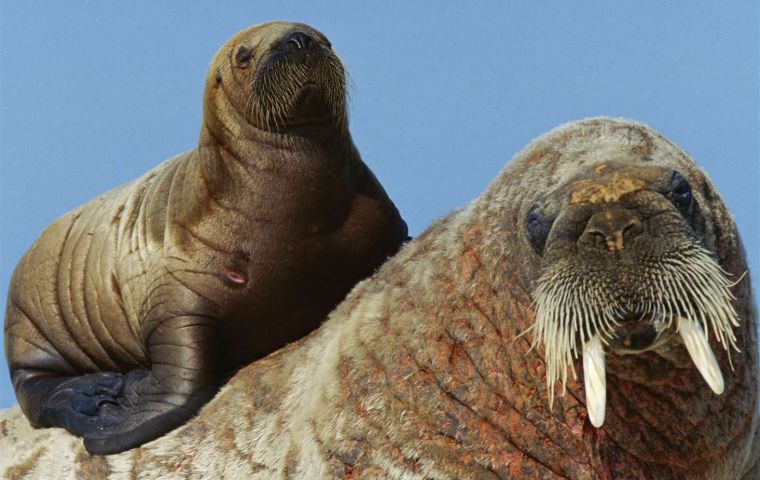MercoPress. South Atlantic News Agency
BAS and WWF invite the public to work on a “Walrus from Space” census
 A 3-month old walrus calf finds refuge on her mother’s back. © Paul Nicklen/National Geographic Stock / WWF-Canada.
A 3-month old walrus calf finds refuge on her mother’s back. © Paul Nicklen/National Geographic Stock / WWF-Canada. British Antarctic Survey (BAS) and WWF are seeking the public’s help to search for walrus in thousands of satellite images taken from space, with the aim of learning more about how walrus will be impacted by the climate crisis. It’s hoped half a million people worldwide will join the new “Walrus from Space” research project, a census of Atlantic walrus and walrus from the Laptev Sea, using satellite images provided by space and intelligence company Maxar Technologies’ DigitalGlobe.
Walrus are facing the reality of the climate crisis: their Arctic home is warming almost three times faster than the rest of the world and roughly 13% of summer sea ice is disappearing per decade.
To help safeguard the future of the walrus, we need to know more about them. BAS and WWF are working to better understand these Arctic animals, using space satellites to capture thousands of high-resolution images of walrus congregated on more than 25,000km2 of Arctic coastline – an area larger than Wales.
From the comfort of their own homes, aspiring conservationists around the world can study the satellite pictures online, spot areas where walrus haul out onto land, and then count them. The data collected in this census of Atlantic and Laptev walrus will give scientists a clearer picture of how each population is doing – without disturbing the animals. The data will also help inform management decisions aimed at conservation efforts for the species.
Walrus use sea ice for resting and to give birth to their young. But as sea ice diminishes, more walrus are forced to seek refuge on land, congregating for the chance to rest. Overcrowded beaches can have fatal consequences; walrus are easily frightened, and when spooked they stampede towards the water, trampling one another in their panic. Resting on land (as opposed to sea ice) may also force walrus to swim further and expend more energy to reach their food – food which in turn is being negatively impacted by the warming and acidification of the ocean.
In addition walrus can also be disturbed by shipping traffic and industrial development as the loss of sea ice makes the Arctic more accessible. Walrus are almost certainly going to be impacted by the climate crisis, which could result in significant population declines.
Hannah Cubaynes, wildlife from space research associate at British Antarctic Survey, says: “Assessing walrus populations by traditional methods is very difficult as they live in extremely remote areas, spend much of their time on the sea ice and move around a lot, Satellite images can solve this problem as they can survey huge tracts of coastline to assess where walrus are and help us count the ones that we find.
“However, doing that for all the Atlantic and Laptev walrus will take huge amounts of imagery, much too much for a single scientist or small team, so we need help from thousands of citizen scientists to help us learn more about this iconic animal.”
Chief polar advisor at WWF Rod Downie said that ”Walrus are an iconic species of great cultural significance to the people of the Arctic, but climate change is melting their icy home. It’s easy to feel powerless in the face of the climate and nature emergency, but this project enables individuals to take action to understand a species threatened by the climate crisis, and to help to safeguard their future.
“What happens in the Arctic doesn’t stay there; the climate crisis is a global problem, bigger than any person, species or region. Ahead of hosting this year’s global climate summit, the UK must raise its ambition and keep all of its climate promises – for the sake of the walrus, and the world.”
Previous population estimates are based upon the best data and knowledge available, but there are challenges associated with working with marine mammals in such a vast, remote and largely inaccessible place. This project will build upon the knowledge of Indigenous communities, using satellite technology to provide an up-to-date count of Atlantic and Laptev walrus populations.
Earlier this year Cub Scouts from across the UK became walrus spotters to test the platform ahead of its public release.
Aspiring conservationists can help protect the species by going to wwf.org.uk/walrusfromspace where they can register to participate, and then be guided through a training module before joining the walrus cens




Top Comments
Disclaimer & comment rules-

Read all commentsThe reality of the “climate crisis” is that the climate is behaving the way it always has: https://wattsupwiththat.com/2021/10/26/have-you-seen-the-guardians-climate-disaster-it-appears-to-have-gone-missing/
Oct 27th, 2021 - 03:12 pm 0Commenting for this story is now closed.
If you have a Facebook account, become a fan and comment on our Facebook Page!